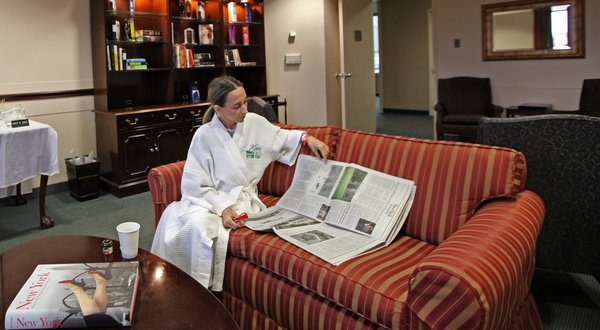News
Chefs, Butlers, Marble Baths: Hospitals Vie for the Affluent

By By NINA BERNSTEIN
New York Times
Published: January 21, 2012
The feverish patient had spent hours in a crowded emergency room. When she opened her eyes in her Manhattan hospital room last winter, she recalled later, she wondered if she could be hallucinating: “This is like the Four Seasons — where am I?”
The bed linens were by Frette, Italian purveyors of high-thread-count sheets to popes and princes. The bathroom gleamed with polished marble. Huge windows displayed panoramic East River views. And in the hush of her $2,400 suite, a man in a black vest and tie proffered an elaborate menu and told her, “I’ll be your butler.”
It was Greenberg 14 South, the elite wing on the new penthouse floor of NewYork-Presbyterian/Weill Cornell hospital. Pampering and décor to rival a grand hotel, if not a Downton Abbey, have long been the hallmark of such “amenities units,” often hidden behind closed doors at New York’s premier hospitals. But the phenomenon is escalating here and around the country, health care design specialists say, part of an international competition for wealthy patients willing to pay extra, even as the federal government cuts back hospital reimbursement in pursuit of a more universal and affordable American medical system.
“It’s not just competing on medical grounds and specialties, but competing for customers who can go just about anywhere,” said Helen K. Cohen, a specialist in health facilities at the international architectural firm HOK, which recently designed luxury hospital floors in Singapore and London and renovated NewYork-Presbyterian’s elite offerings in the McKeen Pavilion in Washington Heights. “These kinds of patients, they’re paying cash — they’re the best kind of patient to have,” she added. “Theoretically, it trickles down.”
A waterfall, a grand piano and the image of a giant orchid grace the soaring ninth floor atrium of McKeen, leading to refurbished rooms that, like those in the hospital’s East 68th Street penthouse, cost patients $1,000 to $1,500 a day, and can be combined. That fee is on top of whatever base rate insurance pays to the hospital, or the roughly $4,500 a day that foreigners are charged, according to the hospital’s international services department.
But in the age of Occupy Wall Street, catering to the rich can be trickier than ever, noted Avani Parikh, who worked for NewYork-Presbyterian as in-house project leader when the 14th floor was undertaken. She pointed to the recent ruckus at Lenox Hill Hospital, where parents with newborns in the intensive-care unit complained that security guards had restricted their movements and papered over hospital security cameras in their zeal to please Jay-Z (real name Shawn Carter) and Beyoncé Knowles, whose daughter was born on Jan. 7 in a new “executive suite.”
Many American hospitals offer a V.I.P. amenities floor with a dedicated chef and lavish services, from Johns Hopkins Hospital in Baltimore to Cedars-Sinai Medical Center in Los Angeles, which promises “the ultimate in pampering” in its $3,784 maternity suites. The rise of medical tourism to glittering hospitals in places like Singapore and Thailand has turned coddling and elegance into marketing necessities, designers say.
The spotlight on luxury accommodations comes at an awkward time for many urban hospitals, now lobbying against cuts in Washington and highlighting their role as nonprofit teaching institutions that serve the poor. Indeed, NewYork-Presbyterian, which once opposed amenities units, would not answer questions about its shift, and declined a reporter’s request for a tour.
In Greenberg, where the visitors’ lounge seems to hang over the East River in a glass prow and Ciao Bella gelato is available on demand, the patient who likened her suite to the Four Seasons was not paying for it. She did not want to be identified because her wealthy boss, who picked up the bill, would not want publicity.
During a reporter’s unofficial visits to both units this month, however, some people enjoying the perks expressed uneasiness about those priced out. In space-starved New York, many regular hospital rooms are still double-occupancy, though singles are now the national standard for infection control and quicker recovery.